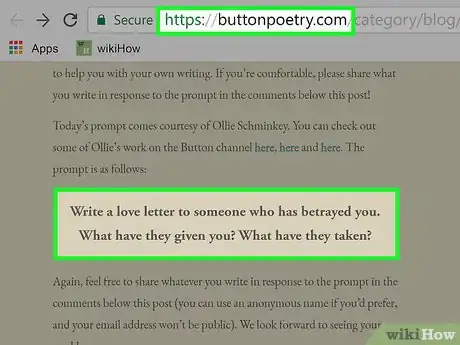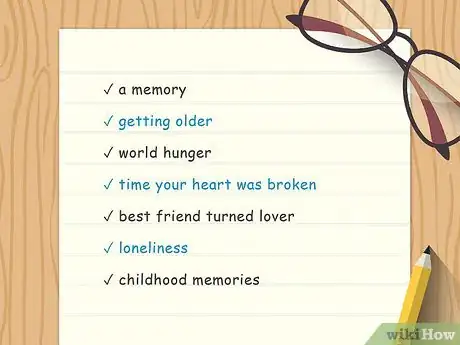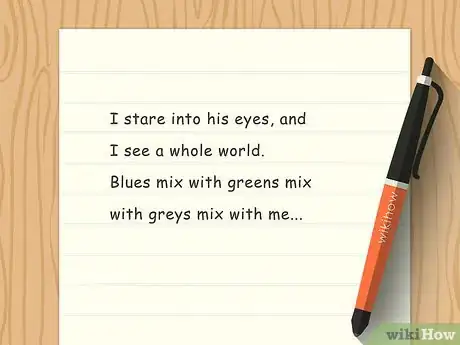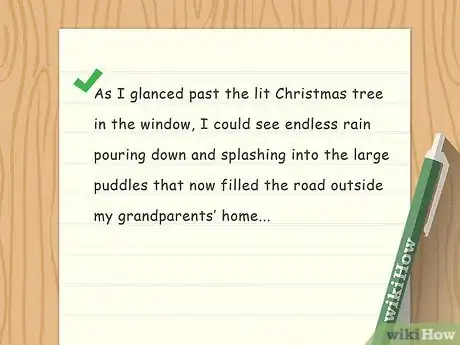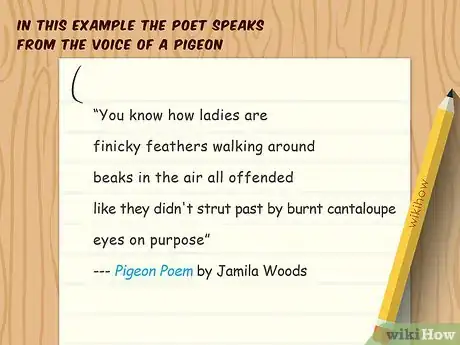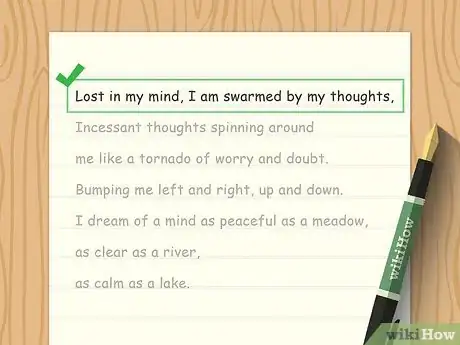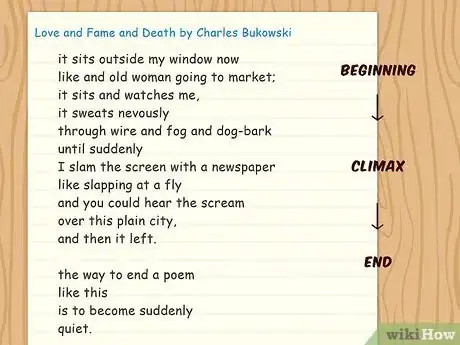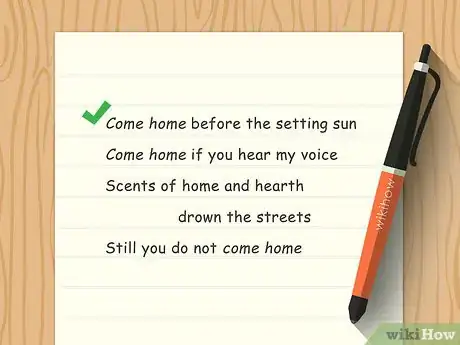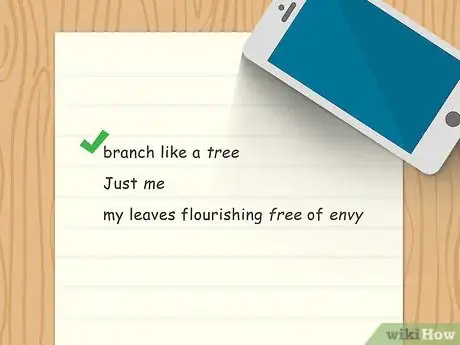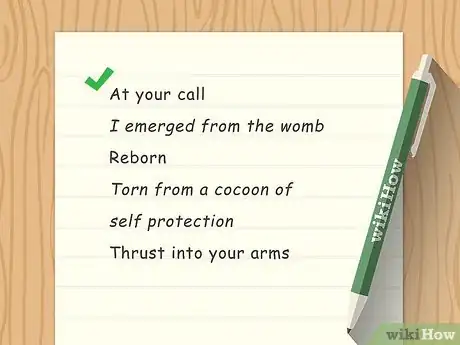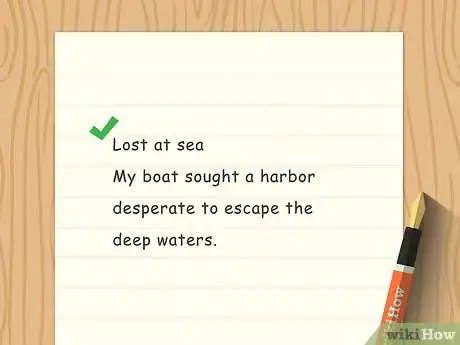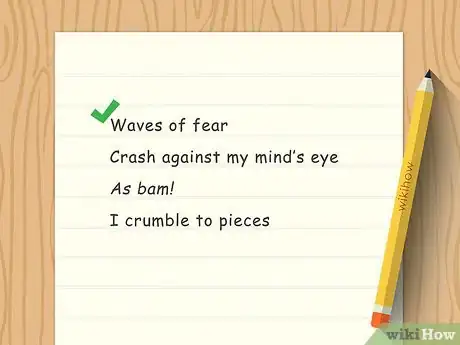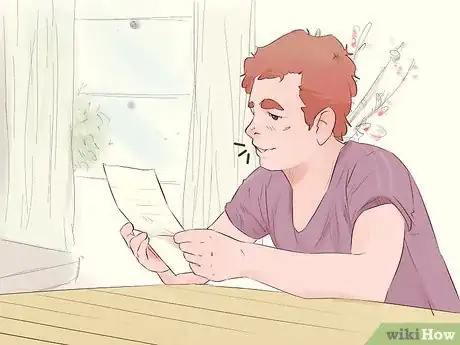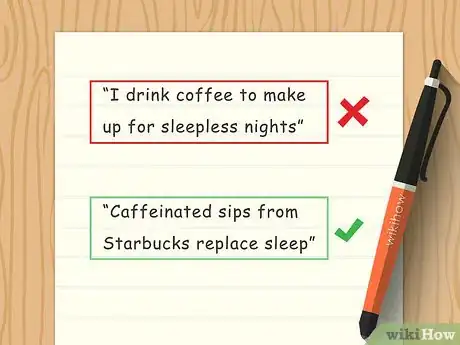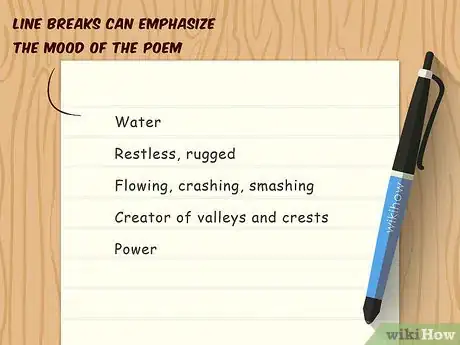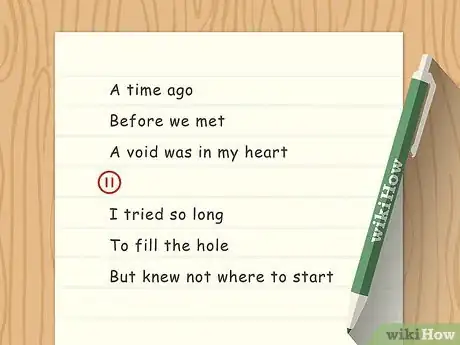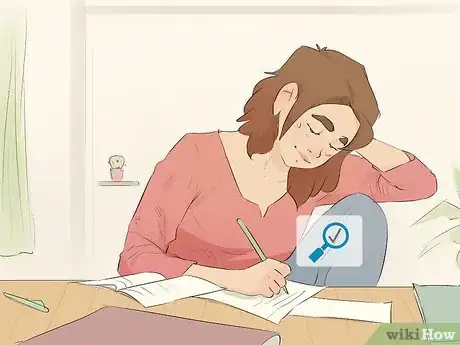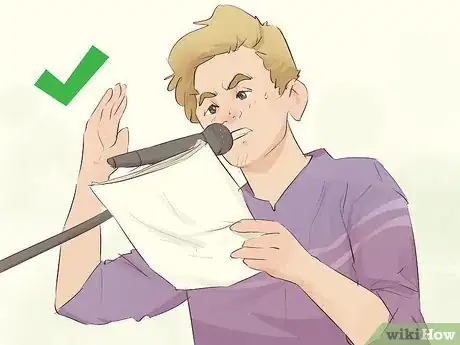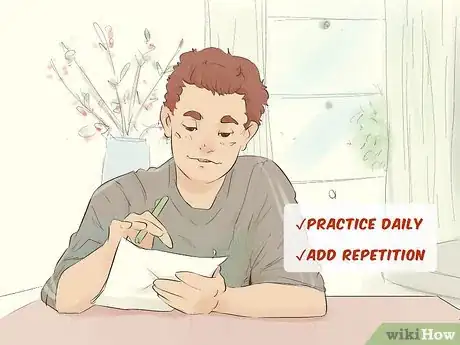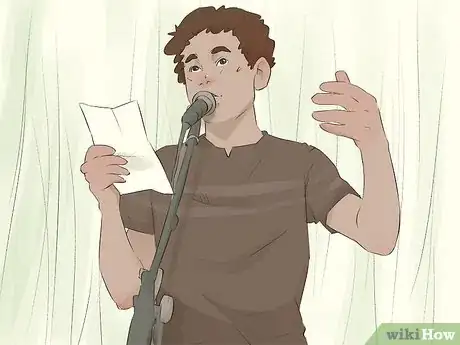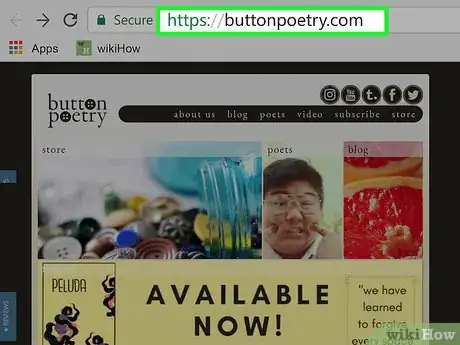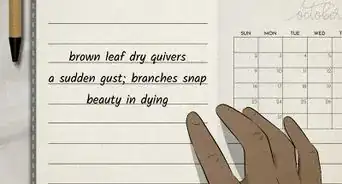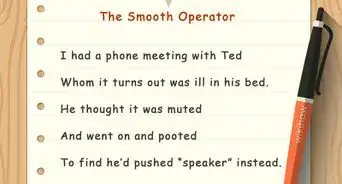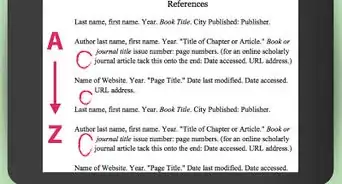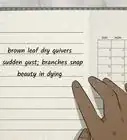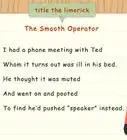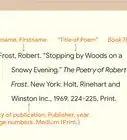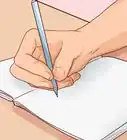This article was co-authored by wikiHow staff writer, Danielle Blinka, MA, MPA. Danielle Blinka is a Writer, Editor, Podcaster, Improv Performer, and Artist currently living in Houston, TX. She also has experience teaching English and writing to others. Danielle holds a Bachelor of Arts in English, Bachelor of Arts in Political Science, Master of Arts in English with a concentration in writing, and Master of Public Administration from Lamar University.
There are 7 references cited in this article, which can be found at the bottom of the page.
This article has been viewed 11,263 times.
Learn more...
Button Poetry is an organization that promotes performance poetry, such as slam poetry and spoken word poetry.[1] To write button poetry, you’ll need to write a poem that is meant to be performed. To get started, brainstorm to identify and expand upon a topic. Then refine your poem for performance. Finally, you'll perform your poem! To be a Button Poet, you'll want to post a video of your poem online, and possibly submit to one of their contests.
Steps
Brainstorming Your Topic
-
1Use a Button Poetry writing prompt. Button Poetry has a section of its website devoted to writing prompts that you can use to get started. Not only can you check out their prompts, but you can read what others have written in response to the prompt if you participate in the Button Poetry community via their website, YouTube, or social media accounts. This is because some poets post their poems or videos of themselves performing them to the community.
- You can find their writing prompts by visiting here: https://buttonpoetry.com/category/blog/writing-prompts/
-
2Write down issues, events, people, or ideas you’re passionate about. You can write about anything, but it helps to choose something that’s close to your heart. Choose a topic that you have a lot to say about. It might help to watch other performance poets either online or in person to get a feel for the topics people choose.[2]
- Consider ways that you identify yourself, such as gender, sexuality, race, favorite hobbies, your passions, or other labels you give yourself.
- Think about the issues you care about, such as animal rights, ending poverty, or supporting those with mental illness.
- Write about the special people in your life, such as your first love, your mentor, a sibling who’s always there for you, an absentee parent, a parent who gave everything for you to succeed, etc.
- Express ideas that interest you, such as falling in love, rebirth, acceptance, starting a new chapter, etc.
Advertisement -
3Draw from your own perspective. Focus on your on views and incorporate your own attitude into the poem. Give yourself permission to open up about the topic you’ve chosen and share your own unique views. It’s okay if people might disagree with you.[3]
- Be bold! It’s normal to feel nervous, but sharing your own perspective is what makes performance poetry so great.
-
4Free write about your topic. Don’t try to shape your thoughts into a poem. Instead, let the words flow onto paper. Write whatever comes to mind, creating line breaks where it feels right. Keep writing until the words aren’t coming anymore.[4]
- You’ll use your free writing to draft your poem later. It’s okay if it looks like prose, a list, or a general collection of notes.
- You can also try an organizational tactic, such as mind mapping.
-
5Choose a voice to shape the poem. In performance poetry, voice is where tone and perspective come together. You'll create voice through word choice, rhythm, and attitude.[5] You may want to deliver the poem in your own voice if you're speaking as yourself. However, you may decide to deliver the poem from a different perspective.[6]
- For example, you might choose to deliver a poem about animal rights from the perspective of a rescue dog.
Drafting Your Poem
-
1Establish your theme in your first line. Your first line should tell your audience what the poem is about. It should also act as a “hook” to pull them in. Review your free writing to identify what you want to convey in your poem. Then create a specific opening image.[7]
- For example, you may be writing a poem about ending a relationship. Your first line could read: "Nights I once gave to you are now spent alone"
-
2Tell a story with a beginning, climax, and end. Your poem won't be as developed as a short story, but it should have the basic elements of a story. You may only suggest story elements and hint at what’s happening. This will help you convey to the audience what you’re trying to say.[8]
- The climax of your poem will pack the biggest emotional punch. It should bring home for the audience what you’re trying to say.
- For example, a poem about ending the relationship may start with a description of the nights spent together. Then it might illustrate troubles in the relationship, climaxing at the moment you broke up. You might then include details of nights after the breakup, concluding with your acceptance of the end.
-
3Use repetition to drive home your point. You can repeat a line, a word, or a sound, depending on what you’re trying to convey. If your poem is on the longer side, you may want to incorporate several areas of repetition to hammer home what you want the listener to take from your piece. It also helps you memorize your poem more easily![9]
- Here is an example: "Come home before the setting sun/Come home if you hear my voice/Scents of home and hearth drown the streets/Still you do not come home"
-
4Incorporate rhyme to improve flow or draw attention. Rhymes aren’t just for the ends of lines. You can use rhyme inside your lines, as well. In fact, placing rhymes at the beginning or middle of lines can create more flow. You may also want to pair several rhyming words together to improve the sound of the poem or create emphasis.[10]
- For example, you could create internal rhyme: "Alone I learned to live without/My doubts always on display/My heart a sleeve for the ripping"
- Repeating your rhyme can create emphasis, such as here: "I branch like a tree/Just me, my leaves flourishing free of envy"
Using Literary Devices
-
1Identify sensory details to add to your piece. Sensory details appeal to the five senses: sight, sound, smell, taste, and touch. These details will bring your piece to life. Try to include examples for each of the five senses. Here are examples of sensory details:[11]
- Sight: "A flourish of rose adorned her cheeks"
- Sound: "Leaves crunched underfoot"
- Smell: "Hints of cinnamon and nutmeg hung in the air"
- Taste: "The morning air held the bitter taste of dry leaves"
- Touch: "Singed skin craved the cool drops of rain"
-
2Use metaphor to create imagery in your poem. A metaphor compares two seemingly unlike things, which allows you to draw connections for the listener. Metaphors allow you to paint a picture with words that conveys how you feel about the subject matter.[12]
- For example, you could compare falling in love to birth: "At your call/I emerged from the womb/Reborn/Torn from a cocoon of self protection/Thrust into your arms"
-
3Add alliteration to play with the sound of your poem. Alliteration is the repetition of the same sounds. Usually, the sound is repeated at the beginning of the words, but it can also be in the stressed syllable. Depending on the letter you choose to repeat, alliteration can create hard or soft sounds in the poem. It will also affect the flow.[13]
- Here is an example of alliteration using the letter "B": "Burned/My budding heart blackened to the touch/Banishing love's burden"
-
4Incorporate personification. Personification gives human attributes to non-human animals or objects, usually to illustrate a point. It allows you to incorporate more imagery.[14]
- For example, you could speak about a boat as if it had feelings: "Lost at sea/My boat sought a harbor/desperate to escape the deep waters."
-
5Add emphasis with onomatopoeia. Onomatopoeia includes sound words, like bam, thunk, or crash. Although you might want to use these sparingly, they can enhance your performance. You might use them to draw emphasis or to create a specific feeling in the poem. Play around with them to see how they fit into what you're trying to say.[15]
- For example, you could use onomatopoeia to add drama to your performance: "Waves of fear/Crash against my mind’s eye/As bam!/I crumble to pieces"
Refining Your Poem
-
1Read your poem aloud. Your poem is meant to be performed aloud, so it’s important that you consider how it sounds when spoken. This will also help you identify the natural flow of the poem and where your line and stanza breaks need to be.[16]
-
2Identify unnecessary words and areas that need revision. Each word in a poem matters, so you only want to include words that add something to the poem. Reading your poem aloud can help you identify words that are clunky and slow down the poem. Cut out words you don’t need, and rephrase clunky language to improve flow.[17]
- Overall, you want to say as much as you can using as few words as possible. At the same time, you want to be specific.
- For example, you’d replace the line “I drink coffee to make up for sleepless nights” with “Caffeinated sips from Starbucks replace sleep”
-
3Create line breaks where you naturally pause. Reading aloud can help you determine the best place for line breaks. What looks good on paper might not have the best rhythm when spoken aloud. Your line breaks will create emphasis and help you establish a rhythm as you perform the poem.
- Look for spots where you naturally stop to take a breath.
- Break your lines where you want to create impact. You can end on that word and allow it to linger for a moment.
- Use line breaks to create emphasis, such as to isolate an important word.
-
4Use stanza breaks to create transitions within your poem. Stanzas may capture a specific image, event, or emotion within your poem. They carry the audience through the story of the poem. Your stanza breaks should follow the natural rhythm of how you speak.[18]
-
5Revise your poem. Read over the poem with a critical eye, cutting out anything that isn’t working. Rewrite clunky or boring phrases, and add more detail in parts that are vague. Finally, proofread your poem to clean up grammar, spelling, and typos.[19]
- Poems often go through several rounds of revisions before the poet is satisfied with the poem.
-
6Share your poem with others. Read the poem for a few friends or fellow poets to get feedback. Take their opinion with a grain of salt, however. It’s your poem, so only use feedback that you agree with.
- It’s helpful to look for a critique group to share your work with. Check the postings in your library, groups on social media, and sites like meetup.com for writer’s groups that meet in your area.
-
7Set the poem aside for at least a week. Taking a break from the poem will allow you to approach it differently. When you come back to the poem, you’ll be able to see what works and what doesn’t.[20]
-
8Revisit the poem with fresh eyes. Re-read the poem after the break and decide if it needs more work. You may want to revise it again to improve your phrasing, enhance the imagery, or clarify your point. If you revise the poem, you may want to share it again to get feedback.[21]
Becoming a Button Poet
-
1Practice presenting your poem. To join the Button Poetry movement, you'll need to perform and distribute your poem. Perform your poem in front of a mirror to get used to presenting it. You may also want to film yourself performing it so that you can see areas that you want to improve. Once you're ready, perform your poem for friends or family that you trust.[22]
-
2Incorporated gestures and facial expressions into your performance. Performance poetry is in the same arena as theater. Rather than just read your poem, you’ll use your facial expressions and body movements to help convey the message and emotions presented in the poem. Watching yourself practice the poem can help you identify areas where you can incorporate more gesturing or expression.[23]
-
3Memorize your poem if you want to focus on the performance. In most cases, memorization is optional. However, it can improve your performance because you won’t have to keep glancing down at the poem. Additionally, it will free up your hands to allow for more gesturing.[24]
- Repetition can help you memorize the poem.
- Practicing daily helps, as well.
-
4Sign up for an open mic night or poetry slam. When your ready, look for a local event where you can perform your poem. Coffee shops, bars, and performance spaces are great places to look. Take a few friends with you so that you know you’ll have the support of the crowd![25]
-
5Post a video of your performance online. Button Poetry is all about creating and distributing performance poetry, so you'll want to share your work with others. Have someone film you performing your poem, or set up a camera and film yourself. Post it online to share with others.
-
6Enter a Button Poetry contest. Button Poetry runs contests to help poets share their work and build an audience. You can usually enter their contests by submitting your work via the contest link.
- To find out about Button Poetry contests, follow them online via their website, YouTube Channel, or social media. For more information, visit their website at https://buttonpoetry.com/.
References
- ↑ https://buttonpoetry.com/about-us/
- ↑ http://www.powerpoetry.org/actions/how-write-slam-poetry
- ↑ http://www.powerpoetry.org/actions/5-tips-spoken-word
- ↑ http://www.digitalpoet.net/6-tips-for-spoken-word-poetry
- ↑ https://www.empoweringwriters.com/toolbox/teaching-voice-in-writing-barbara-mariconda/
- ↑ http://www.digitalpoet.net/6-tips-for-spoken-word-poetry
- ↑ https://thewritepractice.com/write-spoken-word/
- ↑ http://www.digitalpoet.net/6-tips-for-spoken-word-poetry
- ↑ http://www.digitalpoet.net/10-poetic-devices-to-spice-up-your-slam-poetry
- ↑ http://www.digitalpoet.net/10-poetic-devices-to-spice-up-your-slam-poetry
- ↑ http://www.powerpoetry.org/actions/how-write-slam-poetry
- ↑ http://www.digitalpoet.net/10-poetic-devices-to-spice-up-your-slam-poetry
- ↑ http://www.digitalpoet.net/10-poetic-devices-to-spice-up-your-slam-poetry
- ↑ http://www.digitalpoet.net/10-poetic-devices-to-spice-up-your-slam-poetry
- ↑ http://www.digitalpoet.net/10-poetic-devices-to-spice-up-your-slam-poetry
- ↑ https://thewritepractice.com/write-spoken-word/
- ↑ http://www.powerpoetry.org/actions/how-write-slam-poetry
- ↑ http://www.powerpoetry.org/actions/how-write-slam-poetry
- ↑ http://www.digitalpoet.net/6-tips-for-spoken-word-poetry
- ↑ http://www.digitalpoet.net/6-tips-for-spoken-word-poetry
- ↑ http://www.digitalpoet.net/6-tips-for-spoken-word-poetry
- ↑ http://www.powerpoetry.org/actions/how-write-slam-poetry
- ↑ http://www.powerpoetry.org/actions/how-write-slam-poetry
- ↑ http://www.powerpoetry.org/actions/how-write-slam-poetry
- ↑ http://www.powerpoetry.org/actions/how-write-slam-poetry
